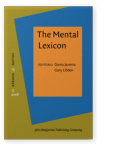Methodological and analytic considerations
Semantic neighbourhoods
There’s an app for that
The contributions of semantic processing have come under increasing attention in recent years (Yap, Pexman, Wellsby, Hargreaves, & Huff, 2012), and variables that measure the
semantic content of words are a requirement of this increased experimental attention. The density and size of semantic
neighborhoods derived from computational models have been shown to predict reaction times across a range of psycholinguistic tasks
(e.g., Danguecan & Buchanan, 2016), and the distance between two words in semantic
space has been shown to predict priming (Kenett, Levi, Anaki & Faust, 2017). The
data to support the construction of stimulus sets that use these variables are complicated to obtain. The app that we describe
here makes these measures of semantics available for 100,000 English words.
Article outline
References
Buchanan, L., Westbury, C. & Burgess, C.
(
2001)
Characterizing semantic space: Neighborhood effects in word recognition.
Psychonomic Bulletin & Review, 81, 531–544.


Danguecan, A. N., & Buchanan, L.
(
2016)
Semantic neighborhood effects for abstract versus concrete words.
Frontiers in Psychology, 71, 1034.


Durda, Kevin K.
(
2013) “
Embodied Properties of Semantic Knowledge Acquired from Natural Language”.
Electronic Theses and Dissertations. 4910.
[URL]
Durda, K. & Buchanan, L.
(
2008)
WINDSOR: Windsor improved norms of distance and similarity of representations of semantics.
Behavior Research Methods, 401, 705–712.


Jones, M. N., Johns, B. T. & Recchia, G.
(
2012)
The role of semantic diversity in lexical organization.
Canadian Journal of Experimental Psychology/Revue Canadienne de Psychologie Expérimentale, 661, 115–124.


Kenett, Y. N., Levi, E., Anaki, D. & Faust, M.
(
2017)
The semantic distance task: Quantifying semantic distance with semantic network path length.
Journal of Experimental Psychology: Learning, Memory, and Cognition, 431, 1470–1489.


Lund, K., & Burgess, C.
(
1996)
Producing high-dimensional semantic spaces from lexical co-occurrence.
Behavior Research Methods, Instruments & Computers, 28(2), 203–208.


Malhi, S. K. & Buchanan, L.
(
2018)
A test of the symbol interdependency hypothesis with both concrete and abstract stimuli.
PLOS ONE, 131, e0192719.


Matchett, K. and Buchanan, L.
(
2018)
Exploring intralexical meaning: Semantic neighbourhood and transparency effects on the reading of compound words.
Manuscript submitted for review.

Mirman, D.
(
2011)
Effects of near and distant semantic neighbors on word production.
Cognitive, Affective, & Behavioral Neuroscience, 111, 32–43.


Rotaru, A. S. & Vigliocco, G., & Frank, S. L.
(
2018)
Modeling the Structure and Dynamics of Semantic Processing.
Cognitive Science.


Shaoul, C. & Westbury, C.
(
2010)
The Westbury Lab Wikipedia Corpus, Edmonton, AB: University of Alberta (downloaded from
[URL]).
Schvaneveldt, R. W. & Meyer, D. E.
(
1973), “
Retrieval and comparison processes in semantic memory”, in
Kornblum, S. (Ed.),
Attention and performance IV, New York: Academic Press, pp. 395–409.

Yap, M. J., Pexman, P. M., Wellsby, M., Hargreaves, I. S. & Huff, M. J.
(
2012)
An abundance of riches: cross-task comparisons of semantic richness effects in visual word recognition.
Frontiers in Human Neuroscience, 6, 72.

Cited by
Cited by 1 other publications
Booton, Sophie A, Elizabeth Wonnacott, Alex Hodgkiss, Sandra Mathers & Victoria A Murphy
2022.
Children’s Knowledge of Multiple Word Meanings: Which Factors Count and For Whom?.
Applied Linguistics 43:2
► pp. 293 ff.

This list is based on CrossRef data as of 6 june 2024. Please note that it may not be complete. Sources presented here have been supplied by the respective publishers.
Any errors therein should be reported to them.
